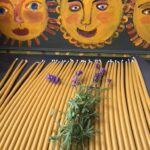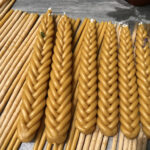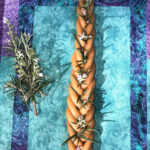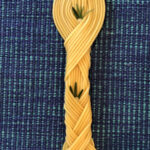

Why I Began Crafting Havdalah Happiness ...
"I was surprised when I had difficulty finding 100% natural beeswax Havdalah candles. An avid appreciator of nature's beauty and the vital importance of human care and conservation for Earth's resources, I delight in finding an ever-growing number of products and people working to ensure that we can live these values. This feels especially important when performing mitzvot and rituals that sanctify time and space, like weekly celebrations of lighting Shabbat candles and making Havdalah. Whether for myself, my family, or a larger gathering, the integrity of the ritual requires that the objects used reflect principles that are sacred to me. Without this harmony, the ritual feels hollow and doesn't resonate as deeply with my soul.
After an exhaustive search without finding the items I was looking for, I quite literally took matters into my own hands, creating these 100% Beeswax Havdalah candles myself from hand-dipped tapers sourced from a monastery and softened by the sun's warmth. I am certain that this ecumenical effort enhances the beauty and spiritual energy within each candle."
~ Rabbi Jessica Shimberg
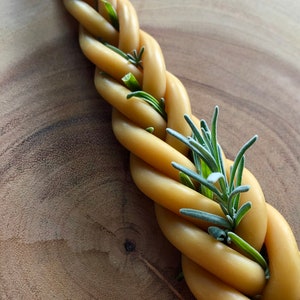
to Purchase HavdalahHappiness & Share the Light
visit Rabbi Shimberg's HoldingtheFringes Shop on Etsy
A portion of the proceeds from each candle sale supports Rabbi Shimberg's extensive volunteerism. Contributions to support her work can also be made through the button at the top right side of this website.
These beautiful Havdalah candles are perfect for ushering in the new week and saying farewell to Shabbat with intention and care. Made of hand-dipped tapers, each Havdalah candle is hand-braided by rabbi and ritual artist Jessica Shimberg. Rabbi Shimberg sets a kavanah/intention for each candle and chants the Hebrew piyyut/prayer poem, Ana B’Khoach (אנא בכח), while she braids the wax strands. The 42 word acrostic piyyut, a mystical text often chanted to welcome Shabbat, uses a different letter of 42-letter Name of the Divine Mystery (the Sacred Source we call by many names) to begin each word and to call upon the strength, wisdom and enduring compassion of the Sacred Source.
Ordained in the lineage of Jewish Renewal, a movement that values incorporation of Jewish mysticism/Kabalah into ritual practice, Rabbi Shimberg finds Ana b’Khoach to be a great source of inspiration and calm. By chanting these words as she creates Havdalah candles with her hands and spirit, she hopes to share a soulful uplift with all who receive them. Havdalah is also a favorite ritual for Rabbi Shimberg as it speaks to and through all of the senses ~ taste (fruit of the vine), smell (spices/herbs), sight (fire of the candle and the light and shadow it provides), sound (singing, prayer, and the dousing of the flame in the wine/juice), and feeling (the warmth of the illuminated candle’s multi-wicked flame). It is a simple and deeply meaningful ritual designed to delineate time and send us into a new week with the renewal of Sabbath rest and delight.
Rabbi Shimberg’s contributions to secular, interfaith and Jewish social and environmental justice work are an important and uncompensated part of her rabbinistry. She also offers learning opportunities and pastoral care to the spiritual and skeptical alike, and assists those interested in Judaism to connect meaningfully to its wisdom, traditions, ritual and growing edges. In addition to the delight of sharing HavdalahHappiness, a significant portion of the proceeds from each candle sale support Rabbi Shimberg’s extensive work helping to repair the world in which we live.

Did you know that bees pollinate one-third of the food we eat? From apples and squash to buckwheat and coffee, bees are responsible for pollinating most of the fruits, vegetables, seeds, and nuts that are essential to our diets.
AND …
Human behavior is one of the greatest threats to the health of bees and other pollinators. The climate crisis, pesticides (in industrial agriculture and individual use), and the loss of foraging habitats (due to urban sprawl and introduction of invasive, non-native species) all result from human treatment of the Earth’s resources as disposable.
How can you participate in living your values through consumer advocacy and choices? The general public can help to protect honey bees and other pollinators by
- reducing herbicide, fungicide and insecticide use, and
- planting pollen and nectar rich plants, shrubs and trees that flower at different times ensuring blooms are present from spring through autumn.
If you are interested in more information about bees and how you can participate in sustainable practices, check out resources available through the EPA, The Bee Conservancy, and Honey Bee Health Coalition.
